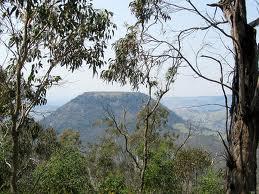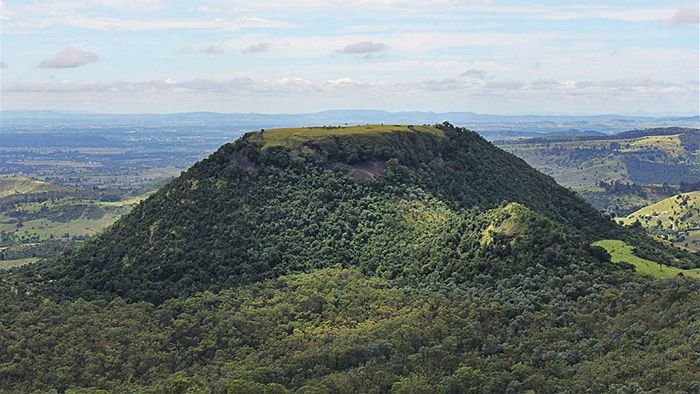Multuggerah (ca. 1820 – 1846) was an Aboriginal warrior and leader of the groups who lived in the Lockyer district and Upper Brisbane valley and surrounds from the early to mid-1800s. He is best known for his role in the Battle of One-Tree Hill at Mt Tabletop near Toowoomba (12-13 September 1843). This battle was one of the few significant defeats of settler forces during the frontier wars. Multuggerah led ongoing resistance and negotiations between settlers and Aboriginal people in the West Moreton district between 1841 and 1846. He was one of the first Aboriginals of Queensland to be celebrated in folklore, featuring in one of Queensland’s earliest bush ballads, ‘The Raid of the Aborigines’ (1845 by William Wilkes), and in Rosa Campbell-Praed’s novel ‘Fugitive Anne’ (1902). According to most reconstructions, he died in 1846 at Glenore Grove.
Multuggerah is recorded in letters, poems and newspaper articles under many names — ‘Moppy’, ‘Young Moppy’, ‘King Moppy’, ‘Campbell’ and ‘Black Campbell’ among them. In some cases, it is uncertain whether these names refer to the same individual. In particular, there is some confusion in early accounts between ‘Old Moppy’ (Multuggerah’s father), ‘Young Moppy’ (Multuggerah) and ‘Campbell’ which may be his brother. In other cases these names seem to be pseudonyms.
Multuggerah was one of at least three sons of ‘Old Moppy’, who was leader of the Gatton area before him. (The common reference to both Multuggerah and his father with variants of the word ‘Moppy’ is likely a reference to their hair). He seems to have been one of the men who assisted Commandant Owen Gorman in locating one of the first passes between the Gatton area and the Darling Downs (‘Gorman’s Gap’) in 1840.
While there were violent skirmishes of which he was likely involved in the time of his father (1840-1841), Multuggerah first emerges in the public record in August 1841 when he tried to attack the party of early settler John ‘Tinker’ Campbell. After being purportedly kidnapped at gunpoint by Campbell, the young Multuggerah, apparently impressed by his captor’s daring, exchanged names and maintained a lifelong commitment to protecting Campbell. This is how Multuggerah acquired his broadly used alias ‘Campbell’.
Following the shooting of his father and Wooinambi (probably his brother) within a short period of time, Multuggerah vowed to kill at least six whites. Although only a young man, like his father, he quickly won the confidence of the ’Mountain tribes’ (which included the peoples of the Downs, Warwick and D’Aguilar Ranges). He seems to have led or organised regular sackings of bullock drays on the track up to the Darling Downs, and the stealing of flocks at Cressbrook. The latter resulted in a stand-off with settler David McConnel. The two struck a type of peace agreement. Multuggerah returned most of the flock in exchange for the promise of his people being allowed to live unmolested on McConnels’ run.
Like his father, Multuggerah concentrated on economic sabotage: destroying and dispersing livestock and the supply of goods (which at that time was largely conducted by bullock drays). However, his planning involved new techniques such as closing and fencing up the roads and attempted magic (using the kidney fat of livestock).
In August and September of 1843, Multuggerah oversaw a large-scale offensive involving several groups. All the sheep runs of the Lockyer and Upper Brisbane regions, and many of the Darling Downs runs, were held in a state of siege by perpetual attacks on the huts. The aim was to starve out the squatters, and cease all European access through the area. Warriors evidently ‘patrolled’ the region in an effort to enact this.
At the height of the siege, a dozen evicted squatters took shelter at Bonifant’s Inn (near today’s Gatton) and sent a plea for assistance to the Border Police. They also organised a large, heavily-armed dray ‘train’ from Ipswich to push up to the Downs. The intent was to try to keep the pass open by force. This set of drays was nevertheless ambushed and sacked by Multuggerah’s men, resulting in a reprisal raid by some 30 to 50 squatters and assistants. After a heated battle, Multuggerah’s group conducted a mock retreat up Mt Tabletop in which the squatters were defeated. The Border Police arrived but were similarly dissuaded from acting. The defeat humiliated the squatters.
However, in a subsequent push by some 70 to 100 squatters, police and soldiers a week or so later, Multuggerah’s fighters were driven out of the area to Rosewood Scrub (a large enclosed brigalow rainforest area 50 kilometres to the east). Rosewood Scrub – the area between today’s Lowood, Laidley and Walloon – became Multuggerah’s stronghold from this point onwards, although he is still mentioned as making attacks from the Helidon Scrub, effective enough for settlers to generally avoid this area. Occasionally settlers were ousted from their homes, but mostly supplies were destroyed or taken. Reprisal attacks by squatters, police and soldiers resulted in Multuggerah’s camps being stormed and burnt, with some loss of life. A soldiers barracks was built at the base of the Dividing Range (near Helidon) to protect the mountain passes against Multuggerah’s attacks, and a fortified hut was built at Rosewood Station (Glenore Grove) on account on the repeated attacks endured here.
The date and circumstances of Multuggerah’s death are disputed. The most widely accepted reconstruction is that Multuggerah under the pseudonym ‘Campbell’ was shot dead in 1846 during a squatters’ reprisal raid on Multuggerah’s Glenore Grove camp. This was after Multuggerah had attempted a siege of Rosewood Station with 500 warriors. However, another account mentions Multuggerah and other leaders fighting Chinese immigrants at Victoria Park (Brisbane) in 1850. One historian even maintains that Multuggerah lived on into the 1880s as ‘King Billy’ of Blackfellows Creek.
Multuggerah is known to have had at least two children, one unnamed son and a daughter known as Kitty or Queen Kitty. Queen Kitty and her husband King Jimmy were prominent figures in Ipswich during the 1860s and 1870s.
Note: Multuggerah’s entry in the Native Mounted Police in Queensland database states that he died in August 1846, along with two unnamed Aboriginal men, during an attack on Rosewood station owned by John and Donald Coutts.
Citation
Ray Kerkhove and Amanda Spinks, ‘Multuggerah (ca. 1820 – 1846)’, Harry Gentle Resource Centre, Griffith University, 2017, https://harrygentle.griffith.edu.au/life-stories/multuggerah/.
Books
Ray Kerkhove , Multuggerah and Multuggerah Way.
Enoggera, Qld: Ray Kerkhove, 2016. Available online: http://nla.gov.au/nla.obj-412361282/.
S. Simpson (transcribed by Gerry Langevad), The Simpson Letter Book
St Lucia, Qld: University of Queensland Press.
Frank Uhr, Multuggerah and the Sacred Mountain
Nundah, Qld: Boolarong Press.
Ray Kerkhove and Frank Uhr, The Battle of One Tree Hill: The Aboriginal Resistance that Stunned Queensland
Tingalpa, Qld: Boolarong Press.
Newspapers
Local Intelligence, Moreton Bay Courier, 5 Sep 1846, p. 2.
Moreton Bay, Sydney Morning Herald, 10 Sep 1844, p. 4.
Raid of the Aborigines, Bells Life in Sydney and Sporting Reviewer, 4 Jan 1845.
Raid of the Aborigines Continued, Bells Life in Sydney and Sporting Reviewer, 11 Jan 1845.
Early Settlement in Queensland, Darling Downs Gazette, 24 Sep 1910.
Early Settlement in Queensland, Darling Downs Gazette, 1 Oct 1910.
Online Resources
'Multuggerah (aka Moppy and Black Campbell)', Native Mounted Police of Queensland Database
Ray Kerkhove, 'Multuggerah (c. 1820 - c. 1846)', Australian Dictionary of Biography




